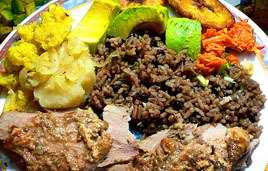Cuban Cuisine: From Riches to Rags (Part II)
Dariela Aquique

HAVANA TIMES — As I wrote in my previous post, Cubans are known, among other things, for their healthy appetites. We like our dishes well-prepared and our servings big. Our eating habits, the broad variety of foods we became accustomed to seeing at our tables at one point, are the result of many culinary influences and recipes.
Our grandparents were taught by their parents to take good care to feed their children well, so that they could grow up healthy and strong. Our parents were taught to prepare as many as six daily meals (including the snacks) and to eat “anything that isn’t nailed down”, as old folk say.
Though the type of breakfast Cuban families ate had depended on their particular tastes, the part of the country they lived in or their income, all considered it one of the day’s essential meals.
Tropical fruits – or their juices and shakes – were a common sight on the breakfast tables of Cuban families of old. So were eggs (in all their various forms), toast, jellies and cereals. The all-time classic Cuban breakfast, however, consisted of buttered toast, white coffee and a strong, hot espresso on the side.
Lunch and dinner, the largest meals of the day, commonly included some kind of meat or protein: beef, fish, seafood, tripe or eggs. Rice, the most popular grain, was commonly accompanied by beans, different kinds of potatoes, and green salads.
Snacks were prepared for families by housewives or consumed at cafeterias and other establishments.
According to a UN report, Cuba had one head of cattle per inhabitant, and was the third largest per capita consumer of beef (below only Argentina and Uruguay) in all of Latin America, before 1959, when roughly 40 kilograms of beef were consumed a year per adult.
Cuba would never report such high figures again, not even in the days of Soviet aid. Even so, and no thanks to rationing measures, there was plenty of meat and its derivatives to go around. Blessed canned meats from Russia! These were true life-savers at Cuba’s rural boarding schools.
After the Berlin Wall fell, cows became as untouchable in Cuba as they are in India. Killing one began to be as serious as killing a person.
As of the notoriously sad days of Cuba’s Special Period, most Cuban homes have not known the six traditional meals of yesteryear. In the darkest times of this economic crisis, in fact, many people went to bed with only a cup of grits in their stomachs.
During that time, Committees for the Defense of the Revolution (CDRs) began handing out hamburger coupons to different neighborhood blocks. People would take these coupons to locales set up by the municipal government. At the entrance, they had to say their full name and their ID and CDR numbers.
Only then could they go into the cafeteria and buy two hamburgers, which came with a side of plantain chips and an instant beverage, for the modest price of eight Cuban pesos. The place felt like a prison cafeteria.
No shortage of unscrupulous individuals sprung up at the time. The most repulsive things these individuals did was sell floor mops – which had been seasoned and fried – as steaks and pizzas with melted condoms for cheese.
As to what people prepared at home to put something on the table….well, it’s best to not even go there (suffice it to recall the plantain peels which were ground up and fried in coconut and other types of oil).
It was during the Special Period that soy foods arrived at our kitchens to stay. Not long ago, Cuba’s legendary leader was suggesting we incorporate the moringa plant into our diets. It would be nice to have a look at what he eats, don’t you think?
To be continued…






Well…at least authentic Cuban cuisean was preserved through the diaspora in Miami.
It must be a constant source of embarrassment to the regime that they have been unable to keep their promise of “….a glass of milk on every table”, and with some of the most arriable land in the world Cuba is still an agricultural wasteland.
In Achy Obejas’ novel, “Ruins”, about life in Havana during the special period, the wife of the protagonist, Usnavy, marinates and cooks cut up pieces of wool blanket as a form of “meat” to serve her family.